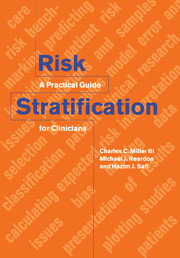4 - Applying published risk estimates to local data
Published online by Cambridge University Press: 22 March 2010
Summary
In this chapter, we discuss the application of published risk estimates to local data. Physicians have known for many years that crude comparisons of treatment outcomes between populations of patients are difficult to interpret because of the heterogeneity among populations with respect to underlying patient risk. Risk-stratification techniques were developed to help account for differences between populations that are attributable to risk factors, in order to facilitate meaningful comparison of the populations. Because of the increasing popularity of risk adjustment in the contemporary health-care environment, risk estimates are available from the literature for many different clinical problems. Published risk studies provide an external reference standard to which local results can be compared. The comparisons that are made between populations in risk-stratification studies are risk-adjusted comparisons that explain part of the variation in outcome between populations as a function of the risk factors that are present in the populations. Riskadjusted comparisons provide for a more realistic comparison of population outcome than crude comparisons alone.
Standardization of rates
All risk stratification involves the mathematical standardization of rates. A rate is simply the accumulation of new events over time. Cancer death rates per year, college student meningitis rates per semester, nursing home nosocomial infection rates per week – all of these rates are events over time, and all could be described by some sort of standardization or stratification procedure. The term “rate” is often applied informally to events that occur over a period without a fixed time interval, such as the period of hospitalization following coronary artery bypass surgery.
- Type
- Chapter
- Information
- Risk StratificationA Practical Guide for Clinicians, pp. 70 - 87Publisher: Cambridge University PressPrint publication year: 2001



